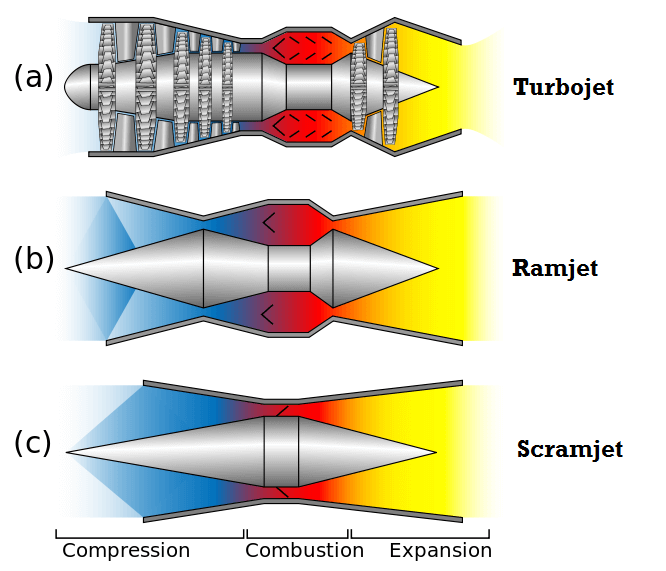
A scramjet engine (short for Supersonic Combustion Ramjet) is a type of air-breathing engine designed to operate at hypersonic speeds—typically above Mach 5 (five times the speed of sound). Unlike traditional jet engines that rely on turbines to compress incoming air, scramjets operate by compressing air using the vehicle’s high-speed motion, without the need for any moving parts.

Types of Engines
Key Features of Scramjet Engines:
- Supersonic Combustion:
- In scramjets, the airflow through the engine remains supersonic (faster than the speed of sound) during all stages of combustion. This distinguishes scramjets from ramjets (another type of air-breathing engine), where the airflow slows down to subsonic speeds before combustion.
- Air-Breathing:
- Scramjets use atmospheric oxygen for combustion, eliminating the need for heavy onboard oxidizers, which makes them lighter and more efficient than rocket engines for high-speed flight.
- High-Speed Operation:
- These engines are designed for hypersonic flight, which means they can operate at speeds exceeding Mach 5 (about 6,174 km/h or 3,836 mph). Scramjets are ideal for use in hypersonic vehicles like missiles, spacecraft, and advanced aircraft.
- No Moving Parts:
- One of the unique characteristics of scramjet engines is that they have no moving parts like turbines or compressors. Air is compressed purely by the vehicle’s speed, which makes the design simpler and more efficient at very high speeds.
How Scramjets Work:
- Air Intake: As the vehicle travels at hypersonic speeds, air enters the engine at supersonic speeds.
- Compression: The incoming air is compressed by the engine’s shape (using shockwaves) as it slows down slightly but remains supersonic.
- Combustion: Fuel is injected into the compressed air and ignited, creating high-pressure, high-temperature gases that accelerate out of the back of the engine.
- Exhaust: The exhaust gases exit at extreme velocities, propelling the vehicle forward.
Applications of Scramjet Technology:
- Hypersonic Missiles: Scramjets can be used to propel weapons at speeds that are difficult to intercept or defend against, making them an important technology for defense applications.
- Space Exploration: Scramjets could enable more efficient atmospheric entry and re-entry for spacecraft.
- High-Speed Aircraft: Hypersonic aircraft capable of flying at speeds above Mach 5 could revolutionize air travel and defense technology.
Scramjet engines are still in the experimental phase, but they hold tremendous potential for revolutionizing aerospace technology, particularly in the realms of defense, space exploration, and high-speed travel.
Also Read: DRDO Achieves Major Milestone with Successful Scramjet Engine Ground Test
Disclaimer
This article is for educational purposes, focusing on the relevance of the topic for UPSC aspirants. Students should stay updated on further developments and refer to official sources for comprehensive preparation.
Follow Fusion IAS



